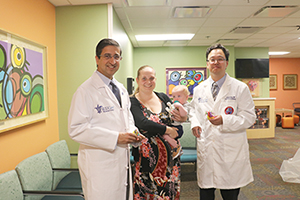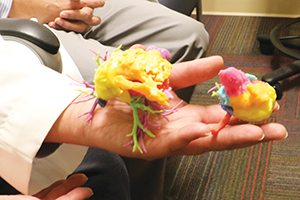By BETSY TAYLOR
ST. LOUIS — Nine-month-old Conner Walkenhorst peers over his mother's shoulder, wide eyes and big grin, mugging for attention and drawing it as only a happy baby can.
He's visiting the Dorothy and Larry Dallas Heart Center at SSM Health Cardinal Glennon Children's Hospital here in July, where he's well-known. Conner was transferred to Cardinal Glennon within 24 hours of his birth at a suburban St. Louis hospital; he stayed at Cardinal Glennon for six months, including two months in the neonatal intensive care unit. Conner has heterotaxy syndrome, a condition in which his internal organs are abnormally arranged in his chest.

Conner Walkenhorst and his mother, Jennifer Walkenhorst, visit in July with Dr. Nadeem Parkar, left, and Dr. Wilson King, two physicians instrumental in the creation of a 3-D Printing Center of Excellence at SSM Health Cardinal Glennon Children's Hospital in St. Louis. Exact three-dimensional models of Conner's heart and a donor heart printed at the center allowed for detailed planning of the baby's heart transplant surgery.
Betsy Taylor/© CHA
"He has a pretty complex anatomy," explains Conner's mother, Jennifer Walkenhorst.
Conner was born with a leaky heart valve. His heart was not positioned in the usual spot and it was connected to the rest of his vascular system in an unusual way. He had a heart transplant on Dec. 16, 2016.
Pediatric cardiothoracic surgeons Dr. Andrew Fiore and Dr. Charles Huddleston, part of the SLUCare Physician Group, led Conner's transplant surgery. The surgeons prepared for the procedure by reviewing models created by a new tool at the children's hospital, a printer at the medical center's 3-D Printing Center of Excellence. Physician specialists and technicians at the center turn a patient's two-dimensional medical images into accurate three-dimensional models. The models allow surgeons to better visualize and plan complex surgeries before they make the first incision. Surgeons also use the models to explain procedures to anxious parents.
In Conner's case, doctors printed both a model of his heart along with the major feeder veins and arteries, and the donor heart. The modeling relies on images of the organs, not the organs themselves. Imaging on Conner was done when he was three days old, and his transplant occurred two months later.
Anatomically correct
Cardinal Glennon opened its 3-D printing center last year; the modeling is also used in procedures at SSM Health Saint Louis University Hospital, located just yards from Cardinal Glennon.
The printer used for Conner's modeling is about 55 inches by 50 inches by 43 inches. Physicians and a technician upload a patient's 2-D scans into software that makes precision measurements and directs the printer to extrude resin layer by layer to make an exact replica. Assorted colors are used to differentiate parts of an organ or of the surrounding anatomy. The models are slightly pliable. A 3-D model usually takes between 10 and 20 hours of printing time to manufacture.
Surgeons can hold the completed models in their hands, and study the anatomy to make a number of decisions such as exactly where to make an incision or insert a catheter. Models made of materials that can be sterilized can be brought in to the operating room.

Before a surgical team at SSM Health Cardinal Glennon Children's Hospital in St. Louis performed a successful heart transplant on two-month-old Conner Walkenhorst on Dec. 16, 2016, they used these 3-D models of the donor's heart, shown at left, and the defective heart the baby was born with, at right, to plan his surgery.
Betsy Taylor/© CHA
Model surgeries
Since about 2000, SLUCare's Dr. Alexander Lin, Cardinal Glennon's chief of pediatric plastic surgery and director of its St. Louis Cleft-Craniofacial Center, and other SLUCare plastic surgeons had sometimes used off-site, commercial 3-D printing companies to create models used to plan complex surgeries. Much of the 3-D printing can now be done in-house at the medical center.
As an example of how the printer can be used, medical center staff explained if a child's skull bones fuse prematurely, the bones need to be divided to allow the brain to grow. Although the divided bones usually grow together, sometimes gaps develop as patients get older. If that's the case, a 3-D print can be made of the skull, then a 3-D printed part can be manufactured as a template that fits the gap precisely. Using that sterilizable model, bone can be traced and cut to fit and cover the skull gap.
Dr. Wilson King, a SLUCare pediatric cardiologist and the 3-D center's medical director, and Dr. Nadeem Parkar, a SLUCare radiologist and chief of cardiac and thoracic imaging for Cardinal Glennon and the nearby SSM Health Saint Louis University Hospital, got fired up about the potential for 3-D printing as a surgical planning tool at a Society for Cardiovascular Magnetic Resonance medical conference in 2014.
They discussed how to provide 3-D printing capabilities to benefit SSM Health patients.
While the university had a 3-D printer on its education campus less than 2 miles from Cardinal Glennon, the doctors said there initially wasn't funding for expensive software to start a 3-D medical printing program. "It was a pretty new technology," King said. "I think the thing was convincing the hospital and the community that this was a worthwhile endeavor."
King and Parkar began working with Sridhar Condoor, a professor of aerospace and mechanical engineering at Saint Louis University's Parks College of Engineering, Aviation and Technology. The men spent hours figuring out how to modify basic software to create a computer program that could translate 2-D images into 3-D medical models accurate down to the millimeter. The program takes measurements from the stacks of images generated when CT or magnetic resonance imaging machines compile a 2-D scan.
The early work and the usefulness of the 3-D models fueled more interest in the 3-D printing center. Donations to the SSM Health Cardinal Glennon Children's Foundation allowed the hospital to purchase new modeling software and two 3-D printers. One installed in 2017 cost about $400,000; the other machine cost $5,000. The materials to print each 3-D model typically cost from $100 to $1,000 depending on the complexity, and King, Parkar and other doctors take on the modeling in addition to their usual workload. A technician, Brian Albers, assists. Thus far, the in-house 3-D printing program has made anatomical models of hearts, skulls, brains, jaws, kidneys, tumors and blood vessels.
Gathering data to prove benefit
Next up, King and Parkar want to collaborate with other hospitals also doing 3-D printing to assess the usefulness of the models in improving patient outcomes.
"If we get enough data, we can show the models are helpful," and identify the specific procedures where the models have been a help. A case then can be made that insurance companies should cover costs related to 3-D modeling, which they don't do now, King explained.
Additionally, the hospital hopes to advance its 3-D capabilities. Beyond medical models, 3-D printing in health care is being developed to create customizable implants, prosthetics and medical devices, with experimental work being done to print tissue and animal organs.
At Cardinal Glennon, the next step to expand its 3-D printing program would be securing additional funding to buy a 3-D printer capable of manufacturing customized valves, hip joints, or other implants, Parkar said.
King said the 3-D technology "really has the ability to help patients."
Conner's mother, Jennifer, of Town and Country, Mo., described the stress she felt when she learned of fetal abnormalities during her pregnancy. The full extent of Conner's medical challenges wasn't clear until he was born. Currently, the baby takes 12 medications a day, and must have limited contact with others, to avoid infection, but in late December he was doing well at home.
She said the 3-D modeling helped to ease her mind, as it allowed doctors to plan — and her to better understand — the procedure for Conner's heart transplant. "It's a huge, huge tool," she said. At a time of uncertainty, "they were able to show us what they were going to do."
Copyright © 2018 by the Catholic Health Association
of the United States
For reprint permission, contact Betty Crosby or call (314) 253-3490.